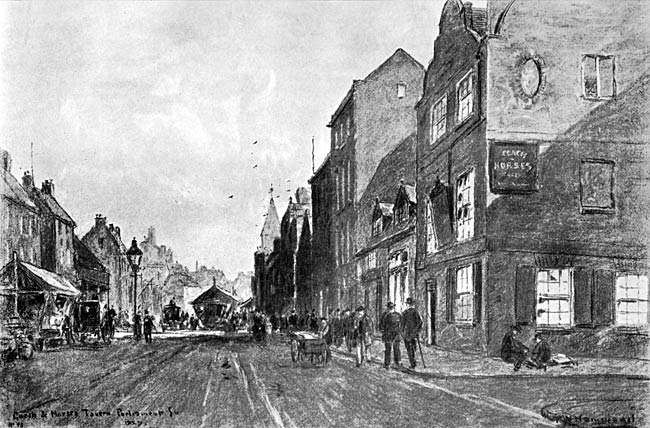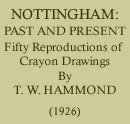< Previous | Contents | Next >
NOTTINGHAM PAST & PRESENT: OLD INNS
COACH AND HORSES TAVERN, Parliament Street, 1887

Parliament Street, which occupies the centre of this drawing, was called 'The Back Side' until about 1770, and throughout its whole length is an extremely wide thoroughfare. The reason for this width is that the town wall of Henry the Second's time extended along the ground which is now the middle of the street. Within this wall was a lane, used as a mustering place and a thoroughfare, and when eventually the wall was pulled down, this lane, the site of the wall, and the wide ditch on its outer side, were thrown into one, and so we got the open space which is of such value to-day.
Near the centre of the picture stands a market stall which is almost opposite the end of Clumbe Street—formerly called 'Cow Lane'—and here stood one of the town gateways known as 'Cow Lane Bar', or sometimes 'North Gate'. Opposite this gateway, near the spot where the policeman now directs traffic, stood the old Maypole of Nottingham, which was not done away with until the end of the eighteenth century.
The Coach and Horses Tavern on the right of the drawing was an interesting old Restoration house, built, as its curved gables show, about the same time as the house next to Marshal Tallard's in Castle Gate. It had a vesical window, very similar to that still existing in the Royal Children Inn, (so called from the family of Queen Anne who was married to the Prince of Denmark, and who took refuge in Nottingham for a short time in 1688, just before her father James I. lost his throne). The 'Coach and Horses' was pulled down about the year 1890 : it is interesting to remember that the ground floor was two steps below the street level, showing that in Parliament Street, as in other parts of the town, the ground level had been considerably raised by the accumulation of debris during the two centuries after this tavern was built.
